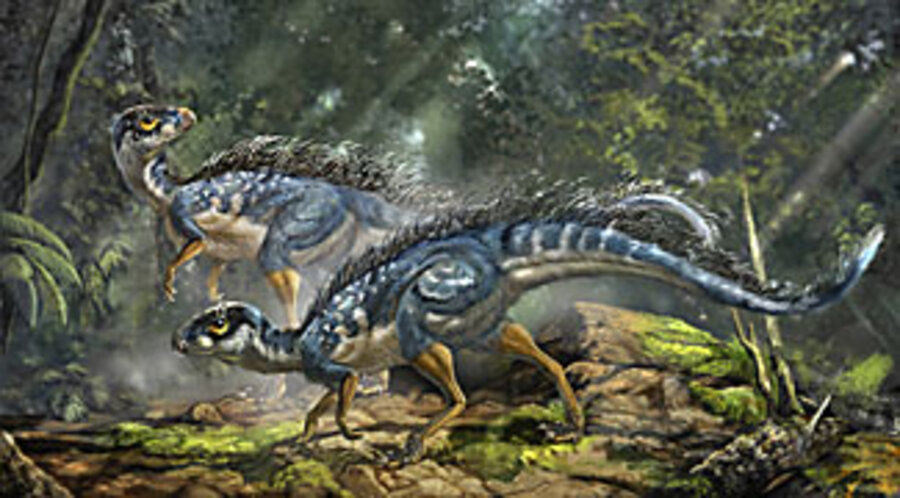Feathery find could rewrite dinosaur history
Since their discovery in the 1990s, feathered dinosaurs have flocked together – their fossil features shepherding them into a broad group of meat-eating beasts whose modern descendants sit on utility lines, tug on earthworms, or decorate statues.
On Thursday, however, scientists in China will report that they have unearthed the fossil remains of a small plant-eating dinosaur that sports what appears to be a primitive form of feather, or protofeather.
The creature, dubbed Tianyulong confuciusi, occupies a spot on the earliest known limb sprouting from what might be called the vegan branch of the dinosaur family tree.
The implication: The origin of the feathers that fill down quilts and adorn peacocks could reach as far back as 230 million years – back to the dawn of dinosaurs themselves.
The find is likely to send paleontologists scrambling to take a fresh look at fossils languishing in museum storage rooms to see if they can find other protofeather candidates.
"We never dreamed that this whole branch of dinosaur evolution would have feathers," says Lawrence Witmer, a paleontologist at Ohio University in Athens, Ohio. "We can now go back and look at existing fossils with new eyes and maybe start to see telltale signs in some of these other animals that tip the evidence one way or another as to whether we're looking at feathers or scales in these dinosaurs."
The newly described creature, nearly 18 inches long, appears to have been a "living fossil" in its own time some 125 million years ago. By then, its direct ancestors already had been around for 70 million years. They shared a common ancestor with the likes of bony-plated creatures such as Stegosaurus and Triceratops.
It's the third of three fossil finds this week that have generated superlatives.
On Monday, a team of scientists in Norway and the United States announced the discovery of "Predator X," a 50-foot-long, 45-ton ocean creature that scientists say ruled the seas some 147 million years ago. Paleontologists with University of Oslo's Natural History Museum unearthed the fossil remains of the four-flippered predator last year from beneath the permafrost on Svalbard, a cluster of islands above the Arctic Circle.
At the other end of the size scale, a pair of Canadian paleontologists reported on Tuesday the discovery of the smallest nonbird meat-eater yet found in North America. The 75-million-year-old fossil remains of the dinosaur, by some estimates roughly the size of a small chicken, were unearthed in 1982 from the Dinosaur Park Formation in Alberta. But no one gave the specimen a serious look until 2007. The results appeared in this week's issue of the Proceedings of the National Academy of Sciences.
The find helps solve a longstanding riddle regarding dinosaurs in North America, the researchers explain. Such pint-sized predators have appeared in the fossil record in Europe, Asia, and the remains today of the once-supercontinent Gondwana. But they seemed to have bypassed North America. No longer.
These disparate discoveries highlight a revolution that has overtaken paleontology during the past 10 to 15 years, according to Jerry Harris, a paleontologist at Dixie State College in St. George, Utah.
To be sure, the painstaking hunt for fossils in the field is an aspect of paleontology that hasn't changed much over the past few centuries, he explains. But new regions that once were closed to Western scientists because of geopolitical tensions or local political instability have opened up. And scientists have gained access to powerful tools back in the lab that have allowed them to gain deeper insights into the physiology of these creatures.
"There are a lot of new techniques and new technologies that are being applied to paleontology," Dr. Harris explains. These include imaging devices initially designed for medical use, as well as computer models "that allow you to take bone that's been crushed for millions of years in the rocks, undistort what it looked like, and then use the reconstruction to put the muscles back on."
This opens the door to insights into how powerful a creature's arms are or how powerful its bite forces are. In Predator X's case, for instance, scientists using these tools estimate that the reptile's jaws had a bite force of 15 tons – 10 times as large as any of today's creatures and four times stronger than T. Rex's.
In T. confuciusi's case, the evidence for protofeathers, or what some researchers call "dino fuzz," appears as strands emerging from its outer skin. After looking at the strands through a powerful microscope, the team, led by Xiao-Ting Zheng at the Shandong Tianyu Museum of Nature in Pingyi, China, interpreted what it saw as the stress lines that one would expect from a flattened hollow tube – the typical form of a feather's central shaft. The team is reporting its results in Thursday's issue of Nature.
Other interpretations for the stands have yet to be ruled out, Dr. Witmer notes. They could represent collagen structures from deeper in the skin, rather than protofeathers. Unfortunately, the tools needed to tell the difference require destruction of some portion of the sample.
If it turns out these strands are protofeathers, it could imply that feathers are common to all types of dinosaurs from the get-go or that the two major branches of dinosaurs evolved feathers independently.





